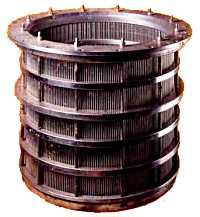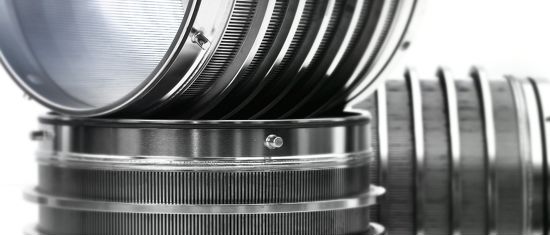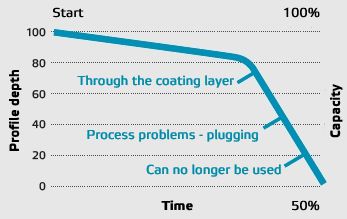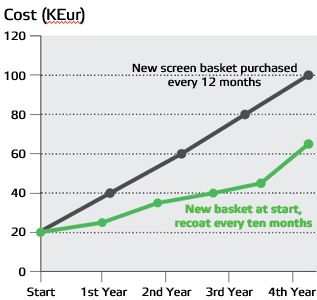The screening process, troubleshooting, warning signs and coating
Jul 23, 2019
Its design is remarkably simple, yet it performs a function so complex and crucial, that without it, the process of converting coarse pulp to high-quality paper would be impossible. Today, the pulp screen's role remains the same as long ago when it was introduced - to remove contaminants from pulp stock. The key to its success is its central component - the screen cylinder. Typically marked by either perforated or drilled holes, or slotted configurations, the screen cylinder uses these apertures to separate good fibers (accepted stock) from foreign materials and clumps of bad fibers (rejected stock).

The screening process
The majority of screen cylinders built today achieve the desired stock capacity and quality by generating turbulence inside the pulp screen through contour reliefs, which surround the cylinder's holes or slots. Measuring only .020 to .060 inches high, the reliefs mix the pulp and allow acceptable fiber to pass through the orifices and into the system, while diverting larger, undesirable fiber agglomerations and contaminants into a reject stream.
Wear to the contour reliefs is inevitable, due largely to abrasive fiber and contaminants. If worn smooth, the reliefs cease to generate shear forces and turbulence, and allow a fiber mat to quickly form over the apertures, blocking fiber flow. The end result is decreased capacity and runnability, thickening of the reject stream, and undesirable fractionation of the feed stock.
To offset these problems, many pulp screens employ a chrome plating inside their cylinders. (Valmet offers special coating for screen baskets, read more about this after the troubleshooting tips.) This is especially the case with stock prep screens, which endure the most wear due to the pulp's rigidity and high concentration of rejects. While the plating does slow cylinder wear, it is not always enough to protect against the rigors of abrasive pulp and constant wear. If the chrome plating is allowed to wear through to the soft alloy of the inner wall and contour reliefs, wear escalates, screen performance deteriorates, and the screen cylinder is destined for the scrap pile.
With cylinder replacement costs ranging from $1,000 to over $100,000 depending on size and style, an effective preventive maintenance program makes good bottom-line sense. The key to such a program is to detect the warning signs indicative of plate wear in its early stages.
Troubleshooting
Warning signs
In general, there are three "red flags" that should immediately tip-off an operator to excessive screen cylinder wear:
- Increased Δ (Delta) P. As the cylinder wears, the ΔP, or the change in pressure required to maintain the pulp flow, creeps up. Struggling against the plugging basket, the ΔP eventually reaches a critical point, while pulp flow diminishes. Most screens are automated and will purge the cylinder if the Δ pressure soars too high. A dramatic increase in the purge rate is a sure sign of plugging.
- Rejects thickening. The screen's reject stream, which is often fed to additional screening treatments, becomes so thick that it plugs the reject line's valves and draws an unusually high motor load.
- Change in freeness. A smooth cylinder promotes fractionation, or a disproportionate separation of long and short fibers. If more long, desirable fibers pass into the rejects, it leaves more short fibers in the accepts. An abundance of short fibers creates "less-free" stock, or stock that drains its water slowly. Detrimental to papermachine production, "less-free" stock (1) forces the papermachine to slow in order to adequately dry the sheet, and (2) produces a weaker sheet due to the short fibers.
Measurement and inspection
Coupled with early detection of operation problems, screen cylinder maintenance requires on-site inspections. Depending on environmental conditions and the frequency and thoroughness of maintenance, a cylinder's life span can vary from six weeks to two years. Upon installation of a new cylinder, the plating/coating should be monitored on a monthly basis to determine the average rate of wear. Once this is established, the plating/coating should be inspected regularly.
One method is to apply dental compound to form a mold. A quick study of the mold usually provides a relatively accurate assessment of wear, but to be safe, should be sent to the screen's OEM for microscopic inspection.
Another effective measurement technique is to combine a visual inspection and a caliper or micrometer reading of wear at the screen's reject end.
In the event the plating/coating requires replacement, it's best that the OEM perform the necessary analysis and repair. Its process engineers are trained to provide the most cost-effective recommendations on replacement versus repair, or a suitable maintenance schedule.
With escalating equipment costs and production demands, paper mills can no longer afford to view the screen cylinder as a disposable component. A regular maintenance program and knowledgeable operators are enough to safeguard mills from replacing the key to the pulp screen's effectiveness.
Valmet screen coating and services

Valmet Screen Coating L
Valmet Screen Coating L is a response to the increasing use of recycled pulp and the special needs of high-wear screening applications. Screen Coating L features the most advanced materials to gain superior wear resistance for screen baskets. The use of our premium coating, Screen Coating L, extends the service lifetime of baskets, resulting in reduced costs for screening.

At a Swedish board mill the life span of baskets used to be 3-6 months. Following the Screen Coating L trial, the baskets are still running after 8 months.
At a Canadian newsprint paper mill the life span of baskets used to be two months. Screen Coating L has more than doubled this. The mill will continue trialling Screen Coating L in other screening positions.
Valmet guarantees that utilizing Screen Coating L results in longer life span of baskets and decreases your operating costs. A longer life span will reduce the number of shutdowns, thus giving more uptime.
Valmet Recoating Services
Usually, the screen basket is operated until it wears down. It then gets plugged and the process must be stopped for a basket change, which naturally reduces capacity. With Valmet’s recoating service, the screening process can be kept stable at all times. Changing baskets before any significant changes in pulp quality occur is essential in this stabilization.

During on-site inspections, Valmet’s service engineers inspect the baskets with a special handheld profile scanner and measure the profile, slot width, wear and general condition of the basket. The screen baskets are also inspected at the Valmet workshop when they arrive for recoating.
Valmet’s standard coating has a thickness of 150 microns. This can be increased up to 350 microns in accordance with process requirements. Valmet’s premium coating, mentioned above (Valmet Screen Coating L) extends the lifetime of screen baskets in highwear screening applications. It features the most advanced materials to gain superior wear resistance for a screen basket. A 20% increase in the lifetime of the screen basket is guaranteed.
The quality of the recoating layer and, therefore, the lifetime of the recoated basket, is the same as the coating of a brand new basket. A screen basket can usually be recoated up to four times before a new basket is required. Correct timing in recoating is most important since worn slots (worn base material in the slots) cannot be closed through recoating.
A report is prepared at every inspection specifying measurements of the current slot width and profile height. The estimated wear rate is calculated by Valmet’s experts through combining this data with information about the installation date and parameters of the basket at the time of installation. The recoating program, tailored individually for each screen, is created once the screen-specific wear rate estimate is determined. Revisits and additional service inspections are used to validate and update the programs.
For the most complete and accurate information on screen operation and maintenance, contact your Valmet representative.